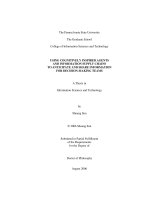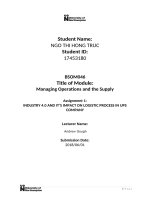Systems Design Project Transport Optimization and Green Supply Chain
Bạn đang xem bản rút gọn của tài liệu. Xem và tải ngay bản đầy đủ của tài liệu tại đây (2.91 MB, 6 trang )
Systems Design Project: Transport Optimization and
Green Supply Chain
Prepared by:
Brian Murphy
Senior in Systems Science and Engineering
Washington University, St. Louis, MO
Phone: (805) 698-5295
Email:
Supervised by:
Mike Cannon
Logistic Functional Manager
Lockheed Martin, O’Fallon, IL
Phone: (618) 334-7309
Email:
Bob Ripeshoff
Chief Architect of Savi Logistics Systems
Lockheed Martin, O’Fallon, IL
Phone: (618) 806-0606
Email :
Background:
The US Government moves more supplies, people and materials by a tremendous
margin than any other entity or organization in the world. Consequently, their supply
chain and transport activities yield tremendous amounts of carbon emissions. The current
administration has made the reduction of carbon emissions a staple of its domestic policy.
In addition, Lockheed Martin, a key provider for the government’s technological and
logistics needs has made it a company-wide imperative to go green. Both the
government and Lockheed Martin can make a significant stride towards this goal by
reengineering their supply chain processes for the purpose of minimizing carbon
emissions.
Aside from reducing carbon emissions, there are a number of other incentives to
go green. A greener and more efficient supply chain will likely reduce the amount of
energy used over the course of the supply chain. This proves beneficial for any company
or supplier looking to reduce expenses as the cost of energy continues to increase. There
is also current and pending legislation that penalizes high energy consumption and carbon
emissions while rewarding a reduction in both. A company’s commitment to a greener
supply chain amounts to less government fees which in turn amounts to a stronger
financial standing. Finally, as consumers’ desire for less carbon intensive goods and
services continues to increase, a forward looking company with a sundry of green
initiatives becomes more appealing to the market.
My Contributions:
Ultimately, the goal of the project is to develop an optimal supply chain that will
reduce carbon emissions and, in turn, reduce total supply chain costs. The first step
towards that goal involves thorough research of a current supply chain. What needs to be
established are the resources and demands that drive the supply chain. The resources
generally include suppliers, manufacturing plants, storage facilities, distribution centers
and the methods of transportation in between. The demand simply includes what the
customer orders.
Once the aforementioned pieces of information are known, the supply chain can
be visually mapped out and both a phase-by-phase and holistic grasp of how the supply
chain functions can be achieved. From there, it is necessary to identify the costs
associated with each phase of the supply chain (i.e. storage costs, transportation costs,
manufacturing costs, energy costs etc.). In addition, once we know the methods of
transportation used across the supply chain, we need to calculate their respective carbon
emissions.
Once we have compiled all of this data, we can begin to mathematically model
the system and use linear programming to find an optimal utilization of the resources
within the supply chain that minimizes carbon emissions and total costs while satisfying
customer demand. The supply chain information gathered from the research will also be
utilized to formulate the associated constraints of this linear programming model.
Methods and Technology Employed:
A simple example of a simply chain can be visualized as follows:
When we seek to form a linear programming problem based on the above model, the
main issues are determining the choice of available facilities and designing the
transportation routing between parties to satisfy customer demand while reducing overall
supply chain costs (although, for the purpose of this project, the goal is to reduce
greenhouse gases and costs). This sort of problem is generally constrained by capacity
limitations for suppliers, manufacturers and distribution centers.
The objective function for this example will reflect a minimal cost (to reiterate,
the objective function for this project will reflect minimal costs and carbon emissions)
and is generally composed of five parts. The first three parts include the raw materials,
manufacturing, holding costs and the transportation between parties. The other two parts
represent the fixed operating costs of plants and warehouses. All these things considered,
we end up with the following variables:
And an optimization problem that looks like this:
Represent capacity constraints of
suppliers, plants, distribution centers and
customers respectively.
Ensures item is delivered to only operating
plants and warehouses respectively
Expected Outcomes:
Using the data acquired on methods of transport and their respective carbon
footprints along with the data acquired on the resources and demands that drive the
supply chain, we hope to formulate a modified version of the general model described
above that will lead to significant reductions in carbon emissions and, in turn, costs.









